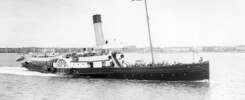
On Friday 5th December 1969 Eppleton Hall reached the midway point in her crossing of the Atlantic. She had set off from the Tyne in September. After making calls at Lisbon, Funchal in Madeira and Las Palmas in the Canary Islands she had set off from Mindello in the Cape Verde Islands on 23rd November for her trans-Atlantic voyage. She had a bunker capacity to take her halfway across with enough fuel for the other half stowed in drums on deck. These had all been emptied into the ship’s own bunker tanks and then tossed overboard so the decks were clear again now.

There were no baths or showers aboard Eppleton Hall so the crew had rigged up a makeshift plunge in a rubber dinghy on the foredeck. In this picture it is occupied by the ship’s master Captain Scott Newhall.

Filling up the time on a long voyage across an ocean where no land is in sight day after day after long day can be difficult and tasks must be found to fill up the hours to keep boredom away. In this picture Heide Bartz is making the brass of the binnacle hood shine splendidly. The weather was generally excellent during the passage with little wind and much sunshine so from time to time they stopped so that those who wanted could go overboard for a swim.

Knowing where they were was crucial. Eppleton Hall was not fitted with radar and modern electronic chart plotters didn’t exist back then so each and every day at 12 noon Kip Waldo got out his sextant to measure the altitude of the sun above the horizon to work out the latitude and fished out the ship’s chronometer to establish the longitude. Eppleton Hall did have an early version of an echo sounder called a Fathometer but in mid Atlantic that was no use as the water was just too deep for its signal to reach into the darkest depths and bounce back up again. As masters of the Cunard ocean liners were apt to say when a passenger asked them how close they were to land when in mid Atlantic: “Oh about 2 miles away. Straight down.”
The following evening at 6.40pm they picked up a Mayday distress call which came through faintly on the radio from the Swedish boat Skold which had been in Las Palmas at the same time as them. She had engine trouble and required urgent assistance. Unfortunately Eppleton Hall had aboard barely enough fuel to complete her crossing and would have run out of fuel for certain if she had made a diversion so they acknowledged the Mayday and spent the rest of the evening themselves sending out Medway Relay calls to try to alert others.
They learned later that the Skold had ended up wrecked on a reef off one of the Antilles Islands at the entrance to the Caribbean although fortunately all the crew were saved. For all of us today more used to being able to travel from A to B almost anywhere in the world in a day or so it is a good reminder that if you are going to do it by boat the distances involved are huge and your remoteness absolute particularly if you are doing it away from the main trade routes criss-crossed by ships. It is therefore ever a difficult and potentially dangerous activity.
Kingswear Castle returned to service in 2023 after the first part of a major rebuild which is designed to set her up for the next 25 years running on the River Dart. The Paddle Steamer Kingswear Castle Trust is now fund raising for the second phase of the rebuild. You can read more about the rebuilds and how you can help if you can here.
John Megoran
This article was first published on 5th December 2020.


